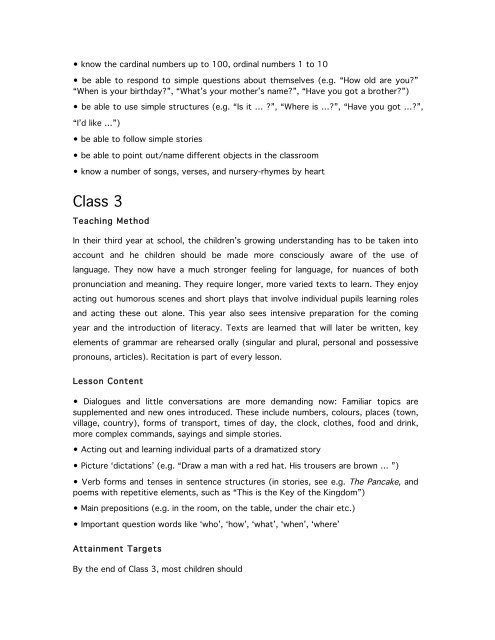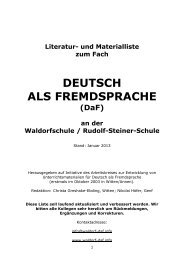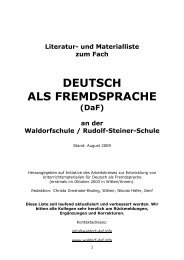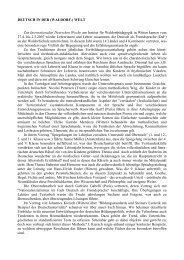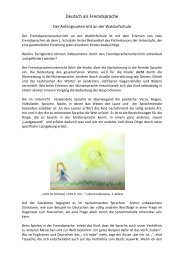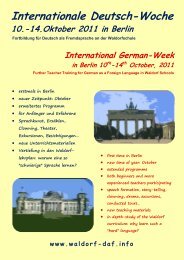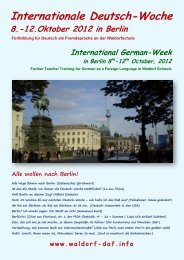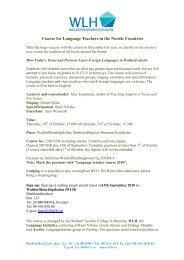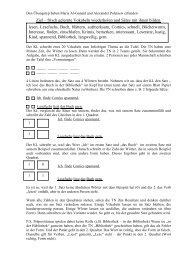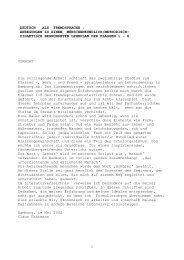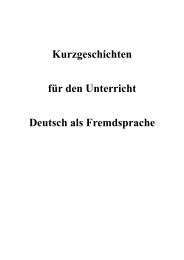Foreign Languages in Steiner Waldorf Education - Waldorf-DaF
Foreign Languages in Steiner Waldorf Education - Waldorf-DaF
Foreign Languages in Steiner Waldorf Education - Waldorf-DaF
Create successful ePaper yourself
Turn your PDF publications into a flip-book with our unique Google optimized e-Paper software.
• know the card<strong>in</strong>al numbers up to 100, ord<strong>in</strong>al numbers 1 to 10<br />
• be able to respond to simple questions about themselves (e.g. “How old are you?”<br />
“When is your birthday?”, “What’s your mother’s name?”, “Have you got a brother?”)<br />
• be able to use simple structures (e.g. “Is it … ?”, “Where is …?”, “Have you got …?”,<br />
“I’d like …”)<br />
• be able to follow simple stories<br />
• be able to po<strong>in</strong>t out/name different objects <strong>in</strong> the classroom<br />
• know a number of songs, verses, and nursery-rhymes by heart<br />
Class 3<br />
Teach<strong>in</strong>g Method<br />
In their third year at school, the children’s grow<strong>in</strong>g understand<strong>in</strong>g has to be taken <strong>in</strong>to<br />
account and he children should be made more consciously aware of the use of<br />
language. They now have a much stronger feel<strong>in</strong>g for language, for nuances of both<br />
pronunciation and mean<strong>in</strong>g. They require longer, more varied texts to learn. They enjoy<br />
act<strong>in</strong>g out humorous scenes and short plays that <strong>in</strong>volve <strong>in</strong>dividual pupils learn<strong>in</strong>g roles<br />
and act<strong>in</strong>g these out alone. This year also sees <strong>in</strong>tensive preparation for the com<strong>in</strong>g<br />
year and the <strong>in</strong>troduction of literacy. Texts are learned that will later be written, key<br />
elements of grammar are rehearsed orally (s<strong>in</strong>gular and plural, personal and possessive<br />
pronouns, articles). Recitation is part of every lesson.<br />
Lesson Content<br />
• Dialogues and little conversations are more demand<strong>in</strong>g now: Familiar topics are<br />
supplemented and new ones <strong>in</strong>troduced. These <strong>in</strong>clude numbers, colours, places (town,<br />
village, country), forms of transport, times of day, the clock, clothes, food and dr<strong>in</strong>k,<br />
more complex commands, say<strong>in</strong>gs and simple stories.<br />
• Act<strong>in</strong>g out and learn<strong>in</strong>g <strong>in</strong>dividual parts of a dramatized story<br />
• Picture ‘dictations’ (e.g. “Draw a man with a red hat. His trousers are brown … ”)<br />
• Verb forms and tenses <strong>in</strong> sentence structures (<strong>in</strong> stories, see e.g. The Pancake, and<br />
poems with repetitive elements, such as “This is the Key of the K<strong>in</strong>gdom”)<br />
• Ma<strong>in</strong> prepositions (e.g. <strong>in</strong> the room, on the table, under the chair etc.)<br />
• Important question words like ‘who’, ‘how’, ‘what’, ‘when’, ‘where’<br />
Atta<strong>in</strong>ment Targets<br />
By the end of Class 3, most children should


